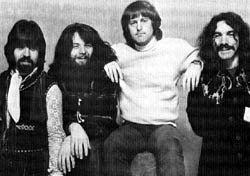[ Previous
| Table of Contents | Next
]

The Byrd exhibited creativity & musicianship similar to that of the Beach
Boys, Dylan, even the Beatles ... however, they had a problem with constant
personnel changes
- Jim McGuinn - folk musician working solo in Greenwich village (like Dylan)
- Gene Clark - folk singer with the New Christy Minstrels
- David Crosby - L.A. folk singer
- Chris Hillman - bluegrass-style mandolin player (& bass) from L.A.
- Mike Clarke - drummer

The Byrds' 1st album, Mr. Tambourine Man (1965), contained 4 Dylan songs(!!!), including the title track
Mr.
Tambourine Man 
(#1, 1965) -
song by Dylan ... note that the version by the Byrds includes only one of four verses, the 2nd: "Take me on a trip ..."
- some claim that this recording represents the
birth of folk rock ... note that this is the same year
of Dylan's infamous appearance at the Newport Folk Festival (see above)
- this single was cut using studio musicians (instead of
band members) with McGuinn on guitar and the group singing
Their second album (Turn Turn Turn, 1965) was named after the song by Pete Seeger (included on the album & a #1 hit)
(#1, 1965) - Pete Seeger tune (adapted the biblical text from Ecclesiastes)

- early 1966 - Gene Clark left the band
- The Byrds remained a quartet, rather than adding another player
- began recording a musically adventurous album (Fifth Dimension; summer,
1966), paralleling developments of the Beatles
(#14, 1966)
- unusual chord progressions
- Dorian mode ... not major or minor
- predominant bass line
- close 3-part vocal harmonies
- 12-string electric Rickenbacker guitar sound (played
by McGuinn)
- "Eight Miles High" was one of the first
records that was actively banned for drug-oriented lyrics (LSD?)
- Byrds maintained that it was "celebrating the joys of airplane
flight" (double-entendre)

- McGuinn's autocratic grip continued to tighten over the band, resulting
in the departure of David Crosby, following the release of Younger than
Yesterday (3/67)
- Crosby went on to form later formed Crosby, Stills, & Nash ... later
adding Neil Young
- contained another cover of a Dylan song "My Back Pages"
(#30 in 1967)
The Byrds performed at the 1967 Monterey Pop Festival
- once again, the departing member was not replaced
- in fact, by 10/68, McGuinn was the only remaining original member
- Mike Clarke left
- Hillman & new member Gram Parsons left to form the Flying Burrito
Brothers
- the following album (by the trio McGuinn, Hillman, & Clarke using addition
studio musicians) is one of the most eclectic and interesting of their career
(The Notorious Byrd Brothers, 1968)
Draft
Morning
effective protest song:
- lyrics - "no hurry to learn to kill and take the will from unknown
faces"
- extramusical sounds of war
- military trumpet call (dissonant against harmonies) - military concept
is in conflict with The Byrds anti-draft sentiments
several songs on The Notorious Byrd Brothers revealed heavy country
influence combined with their rock instrumentation
- harbinger of country rock of the 70s, even more so in their next album
(Sweetheart of the Rodeo)
notice phase shifting during string section
also from The Notorious Byrd Brothers
alternates sections with 5-beats per measure and sections with 6-beats per
measure
Tribal
Gathering
- also from The Notorious Byrd Brothers; moves from jazz-like quintuple
meter to more typical quadruple meter
- recall similar experimentation by the Beatles
- suggests the Byrds' potential as an innovative rock band

Summary of the Byrds:
- cofounders of folk rock (with Dylan)
- precursors of country-rock
- innovative in their use of electronic sound manipulation
[ Previous
| Table of Contents | Next
]



